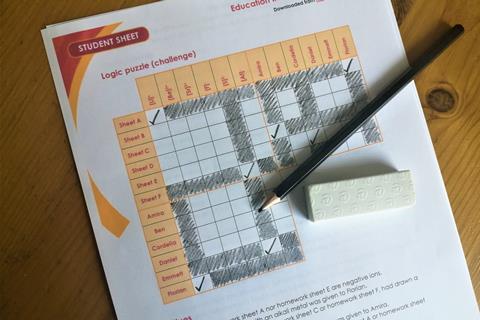Challenge learners to apply problem-solving skills to a grid-based logic problem which relies on chemistry knowledge about ions, charge and periodic table groups
This resource accompanies the Education in Chemistry article Highly charged.
Learning objectives:
- Recognise descriptions of ions based on charge and group number.
- Draw electron configuration diagrams for ions.
Introduction
A teacher set a homework task to draw electron configurations for different ions. Six of the students who handed in their homework sheets forgot to add their names. The students can’t remember which ion they drew but they can remember some of the characteristics of those ions. The teacher has labelled each of the anonymous homework sheets with a letter A–F.
Instructions for learners

Use the clues to solve the logic puzzle to find out which student submitted which ion for their homework.
You should not need a periodic table to help you to solve most of the logic puzzle. You should use your knowledge of group numbers and ion charges.
Instructions for teachers
The logic puzzle is a fun and challenging way to check understanding of the learning objectives. However, some learners may not have come across this style of puzzle before. Working in small groups or completing the puzzle as a whole class will allow learners to access the follow-up worksheet where they can practise drawing ions.
A version of the logic puzzle with only two categories is also provided to support learners who find this format difficult to access. It tests the same scientific knowledge.
Setting a time limit after which the completed grid will be shared with all learners will help to keep the lesson moving and avoid frustration at not being able to complete the puzzle.
Hints and tips
Encourage your learners to attempt the puzzle, even if they haven’t tried anything like this before, by giving the following hints and tips:
- You do not have to go through all the clues in order.
- Look for a clue you can solve easily if you are stuck.
- Skip a clue if you don’t know what to do, you can come back to it later.
- Once you have completed all the clues go through them from the beginning again. You might have new information available the second time around.
- If you have filled in a tick in one of the sections, do you know anything else about the items in that row or column that you can transfer to another section of the grid?
Downloads
Ions logic puzzle - student worksheet
Handout | PDF, Size 0.16 mbIons logic puzzle - teacher notes
Handout | PDF, Size 0.66 mbIons logic puzzle - student worksheet
Editable handout | Word, Size 0.47 mbIons logic puzzle - teacher notes
Editable handout | Word, Size 0.81 mb


























No comments yet